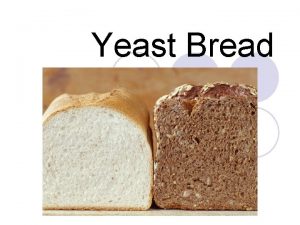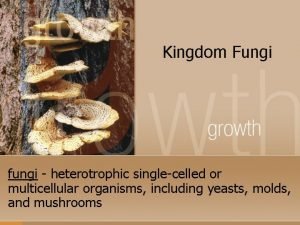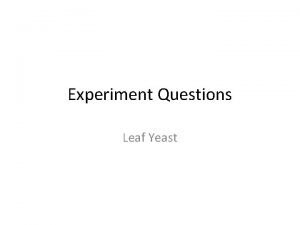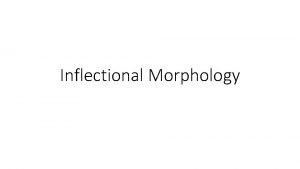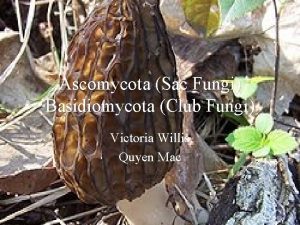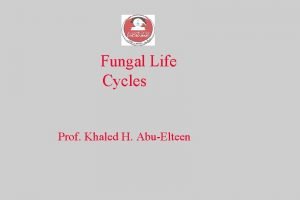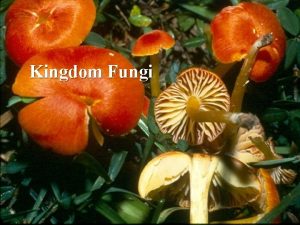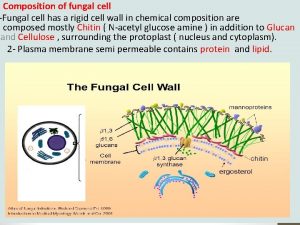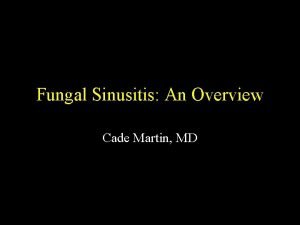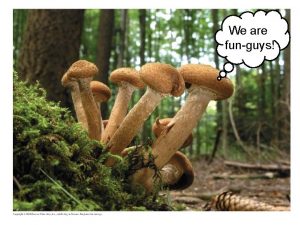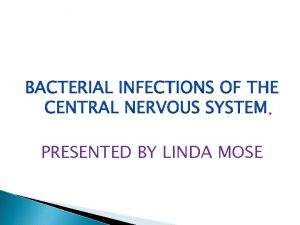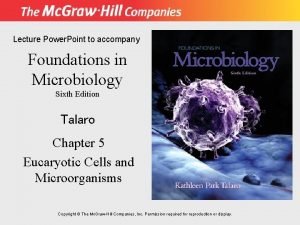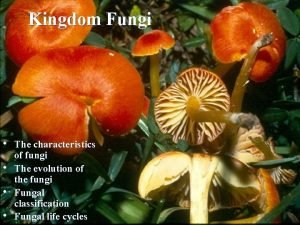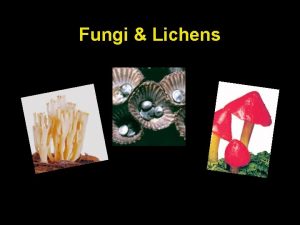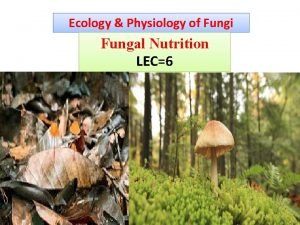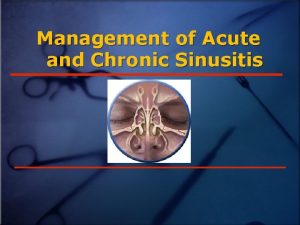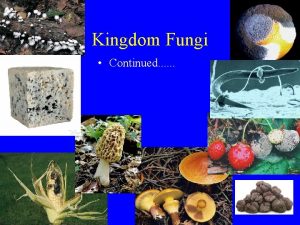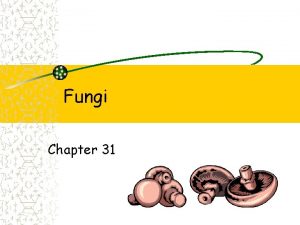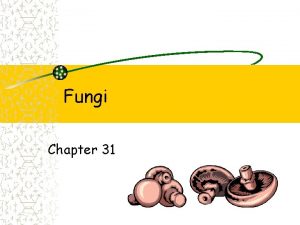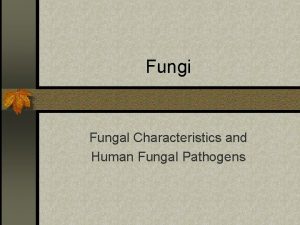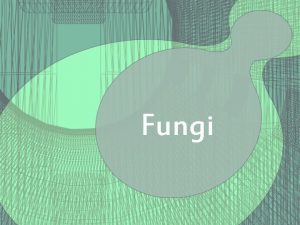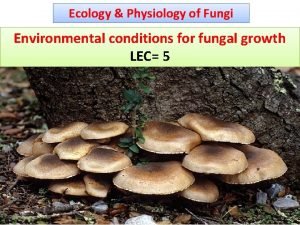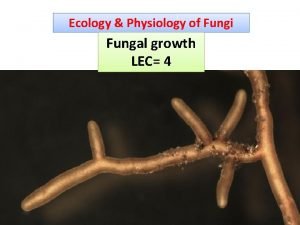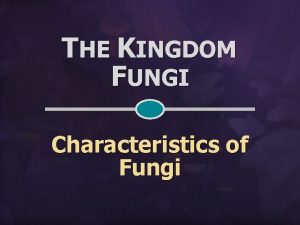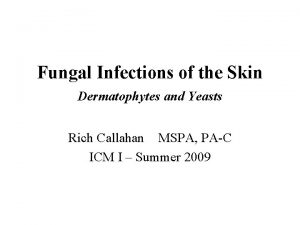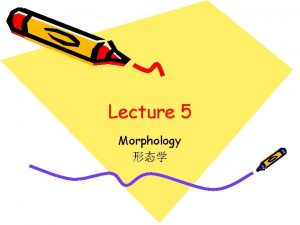Ecology fungal physiology Morphology of Yeasts and Fungi







![3 - Molds & Filamentous Fungi Multicellular, Filamentous with hyphae • Produce conidia [spores] 3 - Molds & Filamentous Fungi Multicellular, Filamentous with hyphae • Produce conidia [spores]](https://slidetodoc.com/presentation_image_h2/a42524946c8eea0eecfcf7485745da11/image-8.jpg)











- Slides: 19

Ecology & fungal physiology

Morphology of Yeasts and Fungi Most fungi are filamentous, many grow as unicellular yeasts and some primitive fungi, such as the chytridomycetes, grow as individual rounded cells or dichotomous branched chains of cells with root-like rhizoids for attachment to a nutrient resource

1 - Yeasts are unicellular(mostly Ascomycete, Basidiomycete or Deuteromycete ) fungi that divide asexually by budding or fission and whose individual cell size can vary widely from 2 to 3 μm to 20– 50 μm in length and 1– 10 μm in width. S. cerevisiae (commonly referred to as baker’s yeast), is generally ellipsoid in shape with a large diameter of 5– 10 μm and a small diameter of 1– 7 μm.

Fungal classification depend on morphology • The morphology of agar-grown yeasts shows great diversity in terms of colour, texture and geometry (peripheries, contours) of giant colonies. Several (e. g. Geotrichum candidum); black (e. g. Aureobasidium pullulans); pink (e. g. Phaffiar hodozyma); red (e. g. Rhodotorula rubra); orange (e. g. Rhodosporidium spp. ); and yellow (e. g. Cryptococcus laurentii). yeasts are pigmented, and the following colours may be visualized in surface-grown colonies: cream (e. g. S. cerevisiae); white

Unicellular, Nucleated rounded fungi • Reproduce by budding • Colony on solid media are usually white to beige and appear much like bacterial colonies • Some genera produce mucoid colonies • Yeast are used in the preparation in the variety of foods

Cell shape Ellipsoid Cylindrical Apiculate Ogival Flask-shaped Miscellaneous shapes Pseudohyphal Hyphal Dimorphic Description Ovoid shaped cells Elongated cells with hemispherical ends Lemon shaped Elongated cell rounded at one end and pointed at other Cells dividing by bud-fission Triangular Curved Spherical Stalked Chains of budding yeast cells which have elongated without detachment Branched or unbranched filamentous cells which form from germ tubes. Septa may be laid down by the continuously extending hyphal tip. Hyphae may give rise to blastospores Yeasts that grow vegetatively Examples of yeast genera Saccharomyces Schizosaccharomyces Hanseniaspora, Saccharomycodes Dekkera, Brettanomyces Pityrosporum Trigonopsis Cryptococcus (e. g. Cryptococcus cereanus) Debaryomyces Sterigmatomyces Candida albicans

2 - Yeast like fungi Fungus that reproduction by budding , but bud fails to separate from parent cell & ultimately from a structure that look like a chain of elongated cell that form pseudo hyphae. Grow partly as yeasts and partly as elongated cells resembling hyphae which are called pseudo hyphae • e. g. Candida albicans
![3 Molds Filamentous Fungi Multicellular Filamentous with hyphae Produce conidia spores 3 - Molds & Filamentous Fungi Multicellular, Filamentous with hyphae • Produce conidia [spores]](https://slidetodoc.com/presentation_image_h2/a42524946c8eea0eecfcf7485745da11/image-8.jpg)
3 - Molds & Filamentous Fungi Multicellular, Filamentous with hyphae • Produce conidia [spores] • Colonies on solid agar are downy, fluffy, cottony • Most mold colonies are pigmented which aid in identification hyphae spores • Penicillium and Aspergillus

Filamentous Fungi The morphologies of macro fungi and micro fungi are very diverse. For example, we can easily recognize a variety of mushrooms and toadstools, the sexual fruiting bodies of certain macro fungi (the higher fungi Asomycotina and Basidiomycotina and related forms), during a walk through pasture or woodland.

Micro fungi (the moulds) are also diverse and are often observed on decaying foods and detritus, whereas many, including the coloured rusts, smuts and mildews, are common plant pathogens. Closer inspection of these visible structures, however, reveals that all are composed of aggregated long, branching threads termed hyphae (singular: hypha), organized to support spores for reproduction and dissemination. The hyphae of these aerial structures extend and branch within the supporting substratum as a network, termed a mycelium, from which the apically growing hyphae seek out, exploit and trans locate available nutrients.

4 - Mold-Yeast Dimorphism • Some fungi have the ability to alternate between a mold form and a that of a yeast form -dimorphic fungi • Several pathogens of humans exhibit dimorphism Candida albicans Histoplasma capsulatum • Dimorphism occurs in response to environmental factors, of which no one common factor e. g. , Histoplasma capsulatum - mold at 25°C, yeast at 37°C e. g. , Mucor rouxii - mold with oxygen, yeast in the absence of oxygen


5 - Fleshy fungi Such as Mushrooms When mushrooms reproduce, they grow a fruiting body that protrudes from the substrate (the ground, wood, whatever they happen to be inhabiting) and produces spores. Basically, a mushroom is a fruiting body that happens to be large enough to see. If you don't collect mushrooms, you will probably think of mushrooms as fruiting bodies shaped like the "normal" mushrooms you buy in the store, but this is only a small fraction of all mushrooms. However, mushrooms come in all sorts of sizes, colors and shapes. If you are uncomfortable calling all of these things mushrooms, you can get scientific and use the term fleshy fungi instead.



Characteristic Mold Habitat Typically found in damp, dark or steam-filled areas. Reproduction Reproduce through small spores, which can be either sexual or asexual. Definition Mold is a fungi that contains multiple identical nuclei. It grows in the form of hyphae of filaments. Appearance Mold has a fuzzy appearance and can be an orange, green, black, brown, pink or purple in color. Can be found in several shapes. Uses Some molds are used in food production, for example, Penicillium is used in the production of cheese, Neurospora in the production of oncom, which is made from the by-product of tofu. Energy Production Secrete hydrolytic enzymes that degrade biopolymers such as starch, cellulose and lignin into simpler substances that can be absorbed. Health Hazards Can cause allergic reactions and respiratory problems Species 1000 s of known species, including penicillium. Yeast Very common. Can be found on fruit and berries, in the stomachs of mammals and on skin, among other places. Most reproduce asexually through mitosis. Most common form called “budding. ” A type of fungi that contains only a single cell. White and thready. Usually oval in shape. Ethanol production, baking, vitamin supplements, study of cell cycle. Convert carbohydrates to alcohol and carbon dioxide in anaerobic through fermentation. Also obtain carbon from hexose sugars. Can cause infection in individuals with compromised immune systems. 1500 known species – 1% of all fungi.

Ultrastructure and Function of Fungal Cells The Fungal Cell Surface The fungal cell wall is a dynamic structure that protects the cell from changes in osmotic pressure and other environmental stresses, while allowing the fungal cell to interact with its environment. The structure and biosynthesis of a fungal cell wall is unique to the fungi, and is therefore an excellent target for the development of antifungal drugs. In filamentous fungi, cell-wall formation and organization is intimately bound to the process of apical growth. Thus, for example in Neurospora crassa, the wall is thin (approximately 50 nm) at the apex but becomes thicker (approximately 125 nm) at 250 μm behind the tip. The plasma membrane component of the fungal cell envelope is a phospholipid bilayer interspersed with globular proteins that dictates entry of nutrients and exit of metabolites and represents a selective barrier for their translocation. Ergosterol is the major sterol found in the membranes of fungi, in contrast to the cholesterol found in the membranes of animals and phytosterols in plants. This distinction is exploited during the use of certain antifungal agents used to treat some fungal infections, and can be used as an assay tool to quantify fungal growth. The periplasm, or periplasmic space, is the region external to the plasma membrane and internal to the cell wall. In yeast cells, it comprises secreted proteins (mannoproteins) and enzymes (such as invertase and acid phosphatase) that are unable to traverse the cell wall. In filamentous fungi, the cell membrane and wall may be intimately bound as hyphae and are often resistant to plasmolysis.


Organelle or cellular structure Function Cell envelope Comprising: the plasma membrane, which acts as a selectively permeable barrier for transport of hydrophilic molecules in and out of fungal cells; the periplasm, containing proteins and enzymes unable to permeate the cell wall; the cell wall, which provides protection, shape and is involved in cell–cell interactions, signal reception and specialized enzyme activities; fimbriae involved in sexual conjugation; capsules to protect cells from dehydration and immune cell attack. Relatively small. Containing chromosomes (DNA–protein complexes) that pass genetic information to daughter cells at cell division and the nucleolus, which is the site of ribosomal RNA transcription and processing. Site of respiratory metabolism under aerobic conditions and, under anaerobic conditions, for fatty acid, sterol and amino acid metabolism. Ribosomes on the rough ER are the sites of protein biosynthesis. Nucleus Mitochondria Endoplasmic reticulum Proteasome Multi-subunit protease complexes involved in regulating protein turnover. Golgi apparatus and Secretory system for import (endocytosis) and export (exocytosis) of proteins. vesicles Vacuole Peroxisome Intracellular reservoir (amino acids, polyphosphate, metal ions); proteolysis; protein trafficking; control of cellular p. H. In filamentous fungi, tubular vacuoles transport materials bidirectionally along hyphae. Oxidative utilization of specific carbon and nitrogen sources (contain catalase, oxidases). Glyoxysomes contain enzymes of the glyoxylate cycle.
 What are the 3 classes of yeast breads
What are the 3 classes of yeast breads Is the kingdom fungi multicellular or unicellular
Is the kingdom fungi multicellular or unicellular Leaf yeast experiment
Leaf yeast experiment Derivational morphology and inflectional morphology
Derivational morphology and inflectional morphology Sac fungi
Sac fungi Fungal life cycles
Fungal life cycles Fungal cell walls are characteristic in having
Fungal cell walls are characteristic in having Fungal cell wall
Fungal cell wall Milady chapter 10 review questions
Milady chapter 10 review questions Candida uveitis
Candida uveitis Allergic fungal sinusitis
Allergic fungal sinusitis Milady chapter 10
Milady chapter 10 Dictyphora
Dictyphora Bacterial vs viral vs fungal meningitis csf
Bacterial vs viral vs fungal meningitis csf Fungal reproduction
Fungal reproduction Chytridiomycota examples
Chytridiomycota examples Sac fungi definition
Sac fungi definition Haustorium in fungi
Haustorium in fungi Allergic fungal sinusitis treatment
Allergic fungal sinusitis treatment Fungal phyla
Fungal phyla
